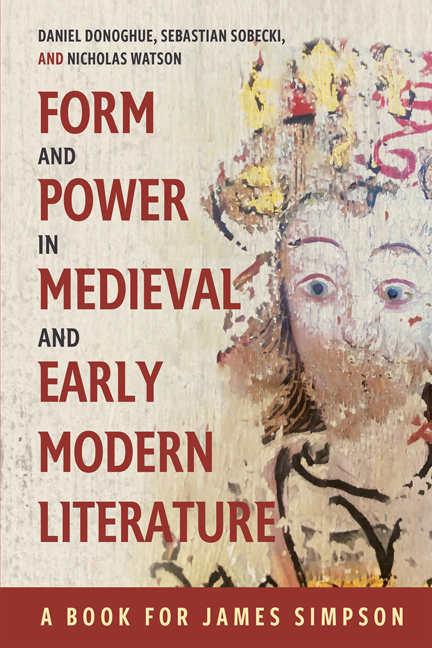Book contents
- Frontmatter
- Contents
- List of Illustrations
- Contributors and Editors
- Acknowledgments
- List of Abbreviations
- Simpson: An Interim Report
- PART I THE HERMENEUTICS OF RECOGNITION
- PART II GENRE AND FIGURE
- PART III CULTURE AND INSTITUTIONS
- PART IV REFORMATIONS
- James Simpson’s Publications from 1984 to 2024
- Bibliography
- A Note on the Bloomfield Conferences
- General Index
- Tabula Gratulatoria
14 - Iconoclasm and the Epigraphic Image
Published online by Cambridge University Press: 17 May 2024
- Frontmatter
- Contents
- List of Illustrations
- Contributors and Editors
- Acknowledgments
- List of Abbreviations
- Simpson: An Interim Report
- PART I THE HERMENEUTICS OF RECOGNITION
- PART II GENRE AND FIGURE
- PART III CULTURE AND INSTITUTIONS
- PART IV REFORMATIONS
- James Simpson’s Publications from 1984 to 2024
- Bibliography
- A Note on the Bloomfield Conferences
- General Index
- Tabula Gratulatoria
Summary
The chancel screen of Binham Priory has figured in twentieth- and twenty-first-century academic literature as a perfect embodiment of the Reformation's iconoclastic effacement of Image with Word. Where the image of the Risen Christ now emerges from beneath the inscribed words (figure 1), the screen has inspired a more implicit historiographic reading, the pentimento a kind of perfect allegory for its own scholarship, for the intellectual resurrection of that enduring pre-Reformation past. However what makes the screen's expression of sixteenth-century epigraphic culture so suggestive is not so much the superimposition of image with word, but the replacement of one kind of image with another: the epigraphic image. Understanding the screen's inscription as an iconoclastic image, an image that attacks but can't escape its own visuality, prompts a reading of the text as itself a kind of historiography: iconoclasm as an historiographical battle of “cultural rupture” that is ultimately unwinnable.
The distinctive materiality of the Binham screen has made it the subject of frequent references by historians of literature, art, religion, and of both medieval and early modern history. The screen therefore has come to represent “Reformation iconoclasm” in general terms, but a detailed study of precisely what makes it so distinctive raises a specific and significant question: how do such inscriptions – as iconoclastic images – respond to what they replace? In the following discussion, I will argue that this particular object can serve, first, as the basis for a theory of the iconoclastic inscription; and second, as a model for its interpretive practice.
In this object, the Binham screen, the rejected image remains underneath. In other instances of iconoclastic epigraphy, the superseded image may not literally be present but is nevertheless in some sense still there. The artists of the later, epigraphic paintings on the Binham screen could not at that point see the earlier ones: they were painting words against a white ground. It is simply an accident of history and chemistry that the painted letters have often protected the under-layer of white from flaking, such that in places the words appear directly against the superseded figures. So what appears to us now is, in fact, a modern image: an anachronism. But conceptually, perhaps it is the opposite of an anachronism: a rare modern visual manifestation of early modern visuality.
- Type
- Chapter
- Information
- Form and Power in Medieval and Early Modern LiteratureA Book for James Simpson, pp. 259 - 274Publisher: Boydell & BrewerPrint publication year: 2024

